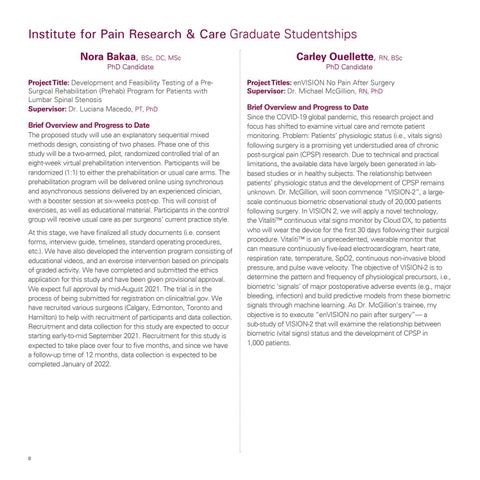Institute for Pain Research & Care Graduate Studentships Nora Bakaa, BSc, DC, MSc
Carley Ouellette, RN, BSc
PhD Candidate
PhD Candidate
Project Title: Development and Feasibility Testing of a PreSurgical Rehabilitation (Prehab) Program for Patients with Lumbar Spinal Stenosis Supervisor: Dr. Luciana Macedo, PT, PhD
Brief Overview and Progress to Date The proposed study will use an explanatory sequential mixed methods design, consisting of two phases. Phase one of this study will be a two-armed, pilot, randomized controlled trial of an eight-week virtual prehabilitation intervention. Participants will be randomized (1:1) to either the prehabilitation or usual care arms. The prehabilitation program will be delivered online using synchronous and asynchronous sessions delivered by an experienced clinician, with a booster session at six-weeks post-op. This will consist of exercises, as well as educational material. Participants in the control group will receive usual care as per surgeons’ current practice style. At this stage, we have finalized all study documents (i.e. consent forms, interview guide, timelines, standard operating procedures, etc.). We have also developed the intervention program consisting of educational videos, and an exercise intervention based on principals of graded activity. We have completed and submitted the ethics application for this study and have been given provisional approval. We expect full approval by mid-August 2021. The trial is in the process of being submitted for registration on clinicaltrial.gov. We have recruited various surgeons (Calgary, Edmonton, Toronto and Hamilton) to help with recruitment of participants and data collection. Recruitment and data collection for this study are expected to occur starting early-to-mid September 2021. Recruitment for this study is expected to take place over four to five months, and since we have a follow-up time of 12 months, data collection is expected to be completed January of 2022.
8
Project Titles: enVISION No Pain After Surgery Supervisor: Dr. Michael McGillion, RN, PhD
Brief Overview and Progress to Date Since the COVID-19 global pandemic, this research project and focus has shifted to examine virtual care and remote patient monitoring. Problem: Patients’ physiologic status (i.e., vitals signs) following surgery is a promising yet understudied area of chronic post-surgical pain (CPSP) research. Due to technical and practical limitations, the available data have largely been generated in labbased studies or in healthy subjects. The relationship between patients’ physiologic status and the development of CPSP remains unknown. Dr. McGillion, will soon commence “VISION-2”, a largescale continuous biometric observational study of 20,000 patients following surgery. In VISION 2, we will apply a novel technology, the Vitaliti™ continuous vital signs monitor by Cloud DX, to patients who will wear the device for the first 30 days following their surgical procedure. Vitaliti™ is an unprecedented, wearable monitor that can measure continuously five-lead electrocardiogram, heart rate, respiration rate, temperature, SpO2, continuous non-invasive blood pressure, and pulse wave velocity. The objective of VISION-2 is to determine the pattern and frequency of physiological precursors, i.e., biometric ‘signals’ of major postoperative adverse events (e.g., major bleeding, infection) and build predictive models from these biometric signals through machine learning. As Dr. McGillion’s trainee, my objective is to execute “enVISION no pain after surgery”— a sub-study of VISION-2 that will examine the relationship between biometric (vital signs) status and the development of CPSP in 1,000 patients.








